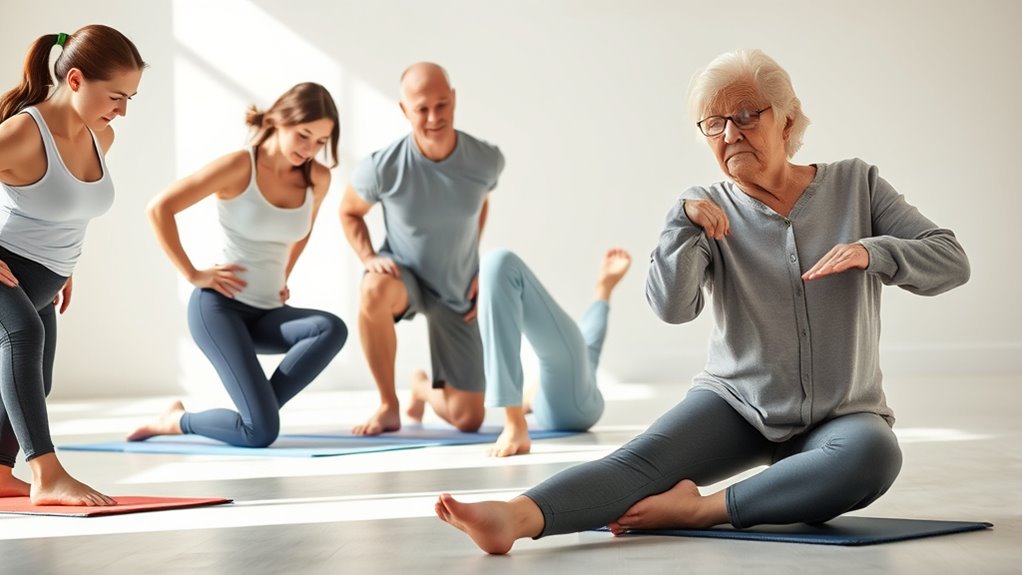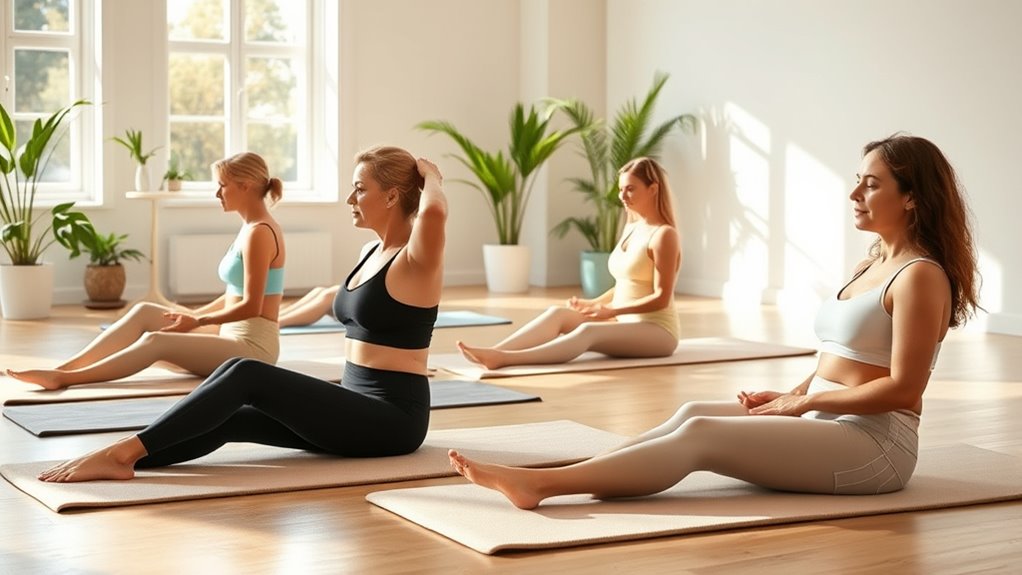Pelvic floor exercises are essential at every age to support bladder, bowel, and sexual health. Whether you’re young, postpartum, middle-aged, or older, strengthening these muscles helps prevent leaks, organ prolapse, and discomfort. Focus on simple exercises like Kegels, maintain good posture, and stay active. Adapting your routine to your life stage maximizes benefits. Keep practicing regularly, and you’ll discover practical tips that can make a real difference in your long-term pelvic health.
Key Takeaways
- Pelvic floor exercises, like Kegels, are beneficial at all ages to support organ health, continence, and sexual function.
- Tailor exercises and intensity based on age, life stage, and physical ability for optimal pelvic health.
- Maintaining good posture, core strength, and proper breathing enhances pelvic floor muscle engagement.
- Regularly practicing pelvic exercises helps prevent or improve issues like leaks and pelvic discomfort across all ages.
- Seek professional guidance during key stages such as postpartum, menopause, or aging to ensure safe and effective routines.
Understanding the Pelvic Floor and Its Functions

What exactly is the pelvic floor, and why is it so important? Your pelvic floor is a group of muscles and tissues that stretch like a hammock across the bottom of your pelvis. It supports your bladder, intestines, and, in women, the uterus. These muscles also play a key role in controlling your bladder and bowel movements, helping you stay dry and find relief when needed. Additionally, they contribute to sexual function and overall core stability. When your pelvic floor is strong and healthy, it works seamlessly to support your organs and maintain continence. But if it weakens, you might experience issues like leaks or pelvic discomfort. That’s why understanding its function is the first step toward maintaining or improving its health. Maintaining a healthy pelvic floor is essential for aging gracefully and ensuring continued independence.
Why Pelvic Floor Health Matters at Every Stage

Your pelvic floor plays a key role in supporting your core stability and maintaining control. Keeping it strong helps prevent incontinence issues and can improve your sexual health. No matter your age or stage of life, caring for your pelvic floor benefits your overall well-being.
Supports Core Stability
Because the pelvic floor plays a crucial role in supporting the body’s core, maintaining its strength is essential for overall stability at every stage of life. When strong, your pelvic muscles help stabilize your spine and pelvis, reducing the risk of injuries and improving posture. This support is vital during daily activities, exercise, and even when lifting or bending. Strengthening your pelvic floor enhances core functionality, making movements more efficient and reducing strain on other muscles. Here’s a visual overview:
| Muscle Group | Function | Benefits |
|---|---|---|
| Pelvic Floor | Support pelvic organs, stabilize pelvis | Improves posture, reduces injury risk |
| Abdominal Muscles | Support spine, aid movement | Enhance core stability |
| Back Muscles | Maintain spinal alignment | Prevent back pain |
| Diaphragm | Assist breathing, core support | Improve breathing and stability |
| Hip Muscles | Enable movement, stabilize pelvis | Increase balance and strength |
Additionally, understanding core stability can help you target these muscles effectively for better health outcomes.
Prevents Incontinence Issues
Maintaining a strong pelvic floor is essential in preventing incontinence issues at any age. When your pelvic muscles are healthy and activated, they effectively support your bladder and control urine flow. Strong muscles help you avoid accidental leaks during daily activities like coughing, sneezing, or exercising. As you age, muscle strength naturally declines, increasing the risk of incontinence. Regular pelvic floor exercises strengthen these muscles, improving their endurance and responsiveness. This proactive approach empowers you to manage or prevent leaks before they start. Consistent practice makes your pelvic muscles more resilient, reducing the likelihood of urinary accidents. Additionally, understanding potential pitfalls in adopting new payment technologies can help healthcare providers implement secure and effective programs for patients. Whether you’re young or older, prioritizing pelvic floor health is a simple, effective way to maintain control and confidence throughout your life.
Enhances Sexual Health
When pelvic floor muscles are strong and healthy, they play an essential role in enhancing sexual health at every stage of life. Strong muscles increase blood flow and sensitivity, making intimacy more pleasurable. They also improve arousal and help maintain natural lubrication. For women, a healthy pelvic floor can lead to more intense orgasms and reduce discomfort during sex. Men benefit from increased erectile strength and better control. Regular exercises strengthen these muscles, boosting confidence and intimacy. Whether you’re in your 20s or 60s, maintaining pelvic floor health supports a fulfilling sex life. It helps you stay connected to your body and enhances overall sexual wellness. Prioritizing pelvic exercises can make a significant difference in your sexual satisfaction now and in the future. Understanding pelvic floor anatomy can further motivate consistent practice and improve results.
Recognizing Signs of Pelvic Floor Weakness

Are you aware of the early signs that indicate your pelvic floor might be weakening? You might notice occasional urinary leaks when you cough, laugh, or exercise. Feeling pressure or heaviness in your pelvis or vagina can also signal weakness. You may experience a sensation of incomplete bladder emptying or difficulty starting urination. Some women notice a decrease in sensation during intimacy or feel that their organs are sagging. Constipation or needing to strain more during bowel movements can be signs too. If you find yourself frequently rushing to the bathroom or experiencing sudden urges, these could point to pelvic floor issues. Recognizing these signs early helps you take proactive steps, including exercises, to strengthen your pelvic muscles and prevent further problems. Additionally, awareness of pelvic floor anatomy can empower you to better understand and address these concerns effectively.
Exercises for Young Adults to Strengthen Their Core

To strengthen your core effectively, focus on core engagement techniques that activate your abdominal muscles properly. Pay attention to your posture and breathing, as they play a crucial role in supporting your exercises. Also, adopting healthy lifestyle habits can enhance your progress and help maintain a strong, stable core over time. Incorporating an understanding of personality traits can also improve your motivation and consistency in maintaining your exercise routine.
Core Engagement Techniques
Engaging your core muscles is essential for improving pelvic floor strength and overall stability. To do this effectively, start by lying on your back with knees bent and feet flat. Place your hands on your lower abdomen and take a deep breath, then gently draw your belly button toward your spine without holding your breath. Focus on tightening your abdominal muscles as if preparing to be gently punched. Keep your pelvis neutral and avoid arching your lower back. As you engage your core, imagine pulling in your lower abs, supporting your pelvic region. Practice this activation during various exercises, ensuring your pelvic floor muscles also stay engaged. Proper beneficiary designation can help you avoid costly errors and maximize your benefits. Consistently using proper core engagement techniques enhances your pelvic health and helps prevent issues down the line.
Posture and Breathing
Maintaining proper posture and practicing controlled breathing are essential for strengthening your core, especially for young adults looking to improve stability and prevent injuries. Good posture aligns your spine, reducing strain and engaging your core muscles naturally. Controlled breathing, such as diaphragmatic breathing, helps activate deep core muscles and promotes relaxation. To maximize benefits, focus on maintaining a neutral spine and deep, steady breaths during exercises. Incorporate these principles into your daily routine for better posture and core strength. Here’s a quick visual guide:
| Posture Focus | Breathing Technique | Benefits |
|---|---|---|
| Keep shoulders back and down | Breathe deeply into your belly | Improves core activation |
| Maintain a neutral spine | Exhale slowly through pursed lips | Reduces tension |
| Engage your abdominal muscles | Inhale through your nose | Enhances stability |
| Stay relaxed and mindful | Synchronize breath with movement | Prevents injury |
A good understanding of posture alignment can significantly enhance your exercise effectiveness and reduce the risk of discomfort or injury.
Lifestyle Habits
Adopting healthy lifestyle habits is essential for young adults aiming to strengthen their core effectively. Regular physical activity, like cardio or strength training, boosts overall muscle tone, including your pelvic floor. Staying hydrated and eating a balanced diet supports muscle health and recovery. Avoid smoking and excessive alcohol, as these habits can weaken your muscles over time. Prioritize sleep to allow your body to repair and strengthen core muscles. Manage stress through mindfulness or relaxation techniques, since stress can cause tension that hampers progress. Limit prolonged sitting; take breaks to move and stretch throughout the day. Incorporating sound healing science into your routine can also promote relaxation and aid in stress reduction, further supporting your core strengthening efforts. By cultivating these habits, you create a foundation that enhances your core strength efforts and promotes overall pelvic health. Consistency in these areas results in better, long-lasting improvements.
Postpartum Pelvic Floor Recovery Strategies

After giving birth, focusing on postpartum pelvic floor recovery is essential for regaining strength and comfort. Start with gentle pelvic floor exercises, like Kegels, to rebuild muscle tone. Practice these daily, contracting and relaxing the muscles without holding your breath or squeezing other muscles. Incorporate deep breathing to relax tension in your pelvis. Avoid strenuous activities until your healthcare provider clears you, and listen to your body’s signals. Using supportive devices, like postpartum pelvic support belts, can provide additional comfort. Stay hydrated and maintain good posture to support healing. Rest when needed, and gradually increase activity levels as you recover. Forsale 100 in pelvic health products can also offer helpful support options. Consistency matters; over time, these strategies will help restore your pelvic health and ease your progression into new motherhood.
Maintaining Pelvic Health in Middle Age

As you move into middle age, your pelvic health becomes increasingly important to support overall well-being and quality of life. To maintain strength and prevent issues, consider these steps:
- Practice regular pelvic floor exercises, like Kegels, to keep muscles active.
- Maintain a healthy weight to reduce pressure on your pelvic area.
- Stay hydrated and eat fiber-rich foods to prevent constipation, which can strain pelvic muscles.
- Avoid excessive heavy lifting or high-impact activities that might weaken or injure your pelvic muscles.
Pelvic Floor Care for Seniors and Older Adults

Maintaining pelvic floor health is essential for seniors and older adults to preserve their independence and quality of life. As you age, your pelvic muscles can weaken, leading to issues like urinary incontinence or pelvic organ prolapse. Regular exercises help strengthen these muscles, giving you better bladder control and reducing discomfort. Start with gentle Kegel exercises, focusing on slow, controlled squeezes and releases. Consistency is key; aim for daily routines to see improvements. If you experience pain or difficulty, consult your healthcare provider for personalized guidance. Incorporating pelvic floor care into your routine can make a significant difference in maintaining mobility and confidence. Remember, it’s never too late to start caring for your pelvic health and enjoy the benefits of a stronger, more resilient pelvic floor.
Tips for Incorporating Pelvic Exercises Into Daily Life

Integrating pelvic exercises into your daily routine can be simple and effective with some planning. Start by choosing specific times to do your exercises, like morning, lunch, or before bed. To make it easier, try these tips:
- Set reminders on your phone or calendar so you don’t forget.
- Pair exercises with daily activities, such as brushing your teeth or waiting in line.
- Keep a small note or sticker in visible places as a visual cue.
- Make it a habit by doing a quick set of exercises right after waking up or before sleeping.
Consistency is key. With a little preparation, you can easily incorporate pelvic exercises into everyday life, improving your health effortlessly.
When to Seek Professional Guidance for Pelvic Health

Knowing when to seek professional guidance is vital for maintaining ideal pelvic health. If you experience persistent pelvic pain, discomfort during exercises, or leakage that doesn’t improve with routine exercises, it’s time to consult a healthcare professional. Also, if you notice a sudden change in bladder or bowel habits, or if you have difficulty controlling these functions, seeking help is essential. Women who are pregnant, postpartum, or approaching menopause should also get regular check-ins to verify their pelvic health is on track. Don’t ignore symptoms or assume they’ll resolve on their own. A pelvic health specialist can assess your condition, guide you through tailored exercises, and address underlying issues early. Getting expert advice ensures you’re doing the right exercises safely and effectively.
Frequently Asked Questions
Can Pelvic Floor Exercises Help With Sexual Health and Satisfaction?
Pelvic floor exercises can markedly enhance your sexual health and satisfaction. By strengthening these muscles, you improve blood flow and sensitivity, which can lead to more intense orgasms. You might also notice increased control and confidence during intimacy. Regularly practicing these exercises helps you stay in tune with your body, making your sexual experiences more pleasurable and fulfilling. So, incorporating them into your routine could be a game-changer for your sexual well-being.
Are There Any Risks Associated With Doing Pelvic Exercises Incorrectly?
You might worry about risks when doing pelvic exercises incorrectly, but they’re usually minimal if you follow proper guidance. If you strain or hold your breath, you could cause muscle strain or discomfort. It’s best to learn the correct technique from a professional or reliable sources. Avoid overdoing it, and listen to your body. Doing exercises properly helps prevent injuries and maximizes their benefits for your pelvic health.
How Long Does It Typically Take to See Improvements?
Time flies when you’re making progress! Usually, you’ll notice improvements in pelvic strength within 4 to 6 weeks of consistent exercises, but it can vary. Keep at it, and don’t get discouraged if results seem slow at first. Regular practice is key; over time, you’ll likely experience better bladder control, core stability, and overall confidence. Patience and persistence pay off in the long run.
Can Men Also Benefit From Pelvic Floor Exercises?
Yes, men can definitely benefit from pelvic floor exercises. These exercises strengthen the pelvic muscles, helping with issues like urinary incontinence, erectile dysfunction, and pelvic pain. You might notice improvements within a few weeks of consistent practice. Regularly engaging in these exercises can enhance your bladder control, sexual health, and overall pelvic strength. It’s a simple, effective way to improve your well-being at any age.
Are There Specific Exercises Recommended for Athletes?
For athletes, specific pelvic floor exercises can boost performance and prevent injuries. You should focus on strengthening and activating these muscles through targeted exercises like Kegels, pelvic tilts, and bridges. Incorporate these into your training routine gradually, ensuring proper technique. Strengthening your pelvic floor helps with core stability, improves endurance, and reduces the risk of incontinence or pelvic issues during intense activity. Consistent practice makes a noticeable difference over time.
Conclusion
So, there you have it—your pelvic floor’s secret weapon against aging, stress, and embarrassing surprises. Think of these exercises as your personal superheroes, quietly saving the day when you least expect it. Skip them, and well, you might just miss out on the fun of staying confident and in control. So go on, give those muscles some love—your future self will thank you, and probably thank you with a little less chaos.









